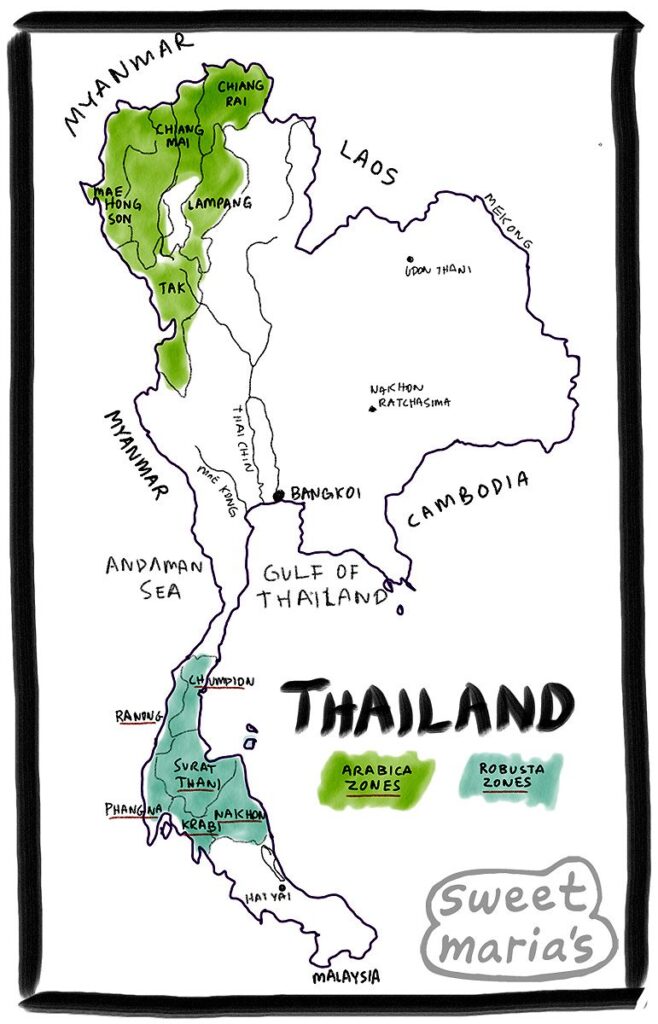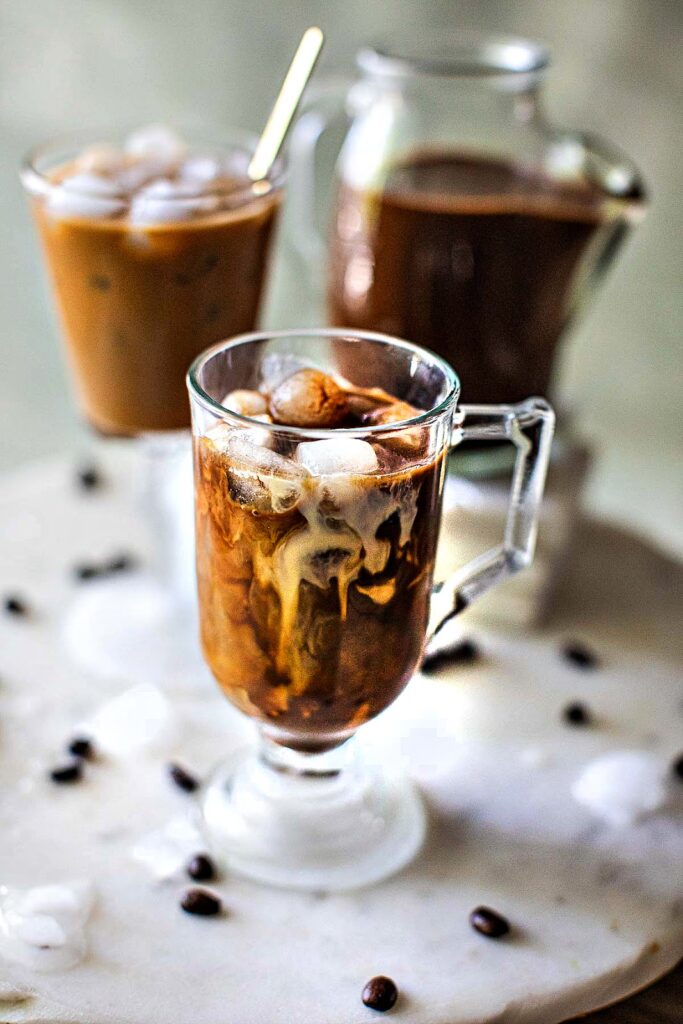
The Rise of Coffee in Thailand
I think it’s almost the same story in so many places; and it goes like this: larger coffee chains systematically scattered across malls and gas stations along every major road, in cities, and for the rise of coffee in Thailand; smaller independently owned coffee shops across the country stealing the limelight from these giants in the coffee scene. And it’s no different here in Thailand.
Coffee arrived in Thailand in the 19th century by King Rama V. Looking to diversify the economy beyond rice, he introduced coffee plants to the cool, mountainous regions in the north, perfect for growing coffee.

Coffee grows in two regions here in Thailand, the North and the South; as a result, these areas are known for cultivating two very distinct coffee varieties. Arabica grows in the Northern region, Robusta flourishes in the south.
Traditionally, Thailand is a Robusta coffee growing country ranking at 25th in the world’s coffee producer’s list.
Robusta beans are grown for industrial use and the rise of growing specialty Arabica beans has taken waves in the North.
Northern Thailand – Arabica Coffee Beans
Northern Thailand heavily contributes to forest preservation and implements many sustainable initiatives in the coffee industry. Coffee growing regions in the north borders with Burma as Laos, infamously known as the Golden Triangle. Coffee beans are grown in Chiang Mai, Chiang Rai, Doi Chang, Doi Tung, and Khun Chang Khian and Mae Hong Son Provinces.
Thailand Coffee variety from The North
From Typica to Pacamara (Bourbon and Catimor too), this coffee region has with it a diverse selection of Arabica beans, all thriving in Chiang Rai’s ideal climate. These beans together with the combination of the ideal climate produces a chocolatey richness with citrusy kick.
Southern Thailand – Robusta Coffee Beans
To the South: in Robusta land, coffee is mainly grown in the provinces of Surat Thani, Chumphon, Ranong, Phang Nga, Thammarat and Krani.
Thailand Coffee variety from The South
Southern Thailand’s sunny beaches aren’t the only things thriving there. The coastal plains offer the perfect climate for growing strong and flavorful Robusta coffee beans. These beans are known for their full-bodied taste with bold flavors and a hint of earthiness. Popular varieties grown there are Catimor and Sarchimor.
Traditional Thai Coffee Brewing Methods
Thailand coffee is a heritage that must be duly paid its respects to, representing it’s old practices, if not in language, or writing, but in food. Here are some of the traditional techniques used to brew coffee in Thailand:
Thai-style Coffee Phin
A phin is a metal filter that lets you make strong, flavorful cups one at a time. Ground robusta beans are filled in it; hot water is poured over it which then drips slowly for a full-bodied brew. Its taste is bold and rich, with hints of caramel sweetness and chocolate.You can decide to add condensed milk or sugar for those of you coffee lovers with a sweet tooth.
Thai Espresso Coffee A.K.A. “Kafe Boran”
Thai espresso, called “kafe boran,” takes its time. This slow brewing process creates a strong and flavorful coffee with a thick, creamy layer on top. It can be enjoyed in two ways: plain, or used as a base for fancy coffee drinks like lattes and cappuccinos.

Source: https://coffeeculture.asia/thai-coffee-recipes/
Thai iced coffee A.K.A. Kafe Yen
This sweet and creamy cup of coffee is the most popular and most commonly found coffee among all types of coffee throughout Thailand.
Traditional Thai Iced Coffee A.K.A. “Oliang”
Oliang is a traditional Thai iced coffee known for its sweetness. But unlike creamy coffees, it has no milk to subdue the strong coffee flavor, which makes the bitterness and aroma of the coffee stand out.

Source: https://www.simplysuwanee.com/thai-coffee/
“Front-wheel lift” A.K.A. “Yok Lor Oliang”
This is a variation of the standard Oliang where milk is added to the black coffee, making it more milky/creamy.
Kopi
This is black coffee mixed with condensed milk. It is Asia’s response for a Latte.
For recipes, visit here!
Thailand Has A Secret Weapon…in Processing Coffee
Which is something called the , just like the monsoon coffee of India.
The honey process bridges the gap between natural and washed coffees. It aims for a balance of fruitiness and sweetness.
Here’s how it works: the coffee cherry’s skin is removed, but some sticky fruit pulp (called mucilage) is left on the beans. This “honey” (not actual honey flavor) dries in the sun with the beans. Careful turning is needed to prevent mold.
Benefits:
- Less fruit surrounds the beans compared to natural processing, reducing unwanted flavors.
- The remaining fruit pulp boosts sweetness in the final cup.
The Ideal Outcome:
A honey-processed coffee might have the brightness of a washed coffee with the lower acidity and fruity notes of a natural coffee. Producers control the sweetness by adjusting the amount of fruit pulp left on the beans.

Source: https://thailandinsider.com/the-rise-of-coffee-production-in-thailand/
For more information on coffee processing methods, read here!
Conclusion
The Coffee landscape in Thailand is a natural blend of tradition and curiosity. With a growing specialty coffee scene popping up in every corner and a local coffee roaster. Thailand is a must-watch underdog in the coffee game
-
1kg Kwararafa Light Roast | Vibrant & Fruity Nigerian Coffee (Ground or Whole Bean)
-
250g Kwararafa Light Roast | Vibrant & Fruity Nigerian Coffee (Ground or Whole Bean)
-
Buna Magic Mug
-
Chemex Combo: Brewing Perfection & Kwararafa Coffee (250gms)
-
Experience Clean Coffee Perfection: TGR 151 Chemex by Tigray Coffee Co.
-
Full Control, Full Flavor: TGR 171 French Press by Tigray Coffee Co.
-
Limited-Time! Save 15% – Tigray Moka Pot & Kwararafa Coffee Combo
-
Tigray Coffee Co. French Press & Coffee Combo: Unwind in Rich Flavor (250g)
-
Unlock Italian Coffee at Home: TGR 101 Moka Pot by Tigray Coffee Co.
- Rwandan Coffee: From Farmer to Fairtrade. - August 8, 2024
- The Rise of Coffee in Thailand - August 1, 2024
- Kenyan Coffee: From Colony to Connoisseur. - July 25, 2024



No Comments